This deliciously savory Pan Fried Teriyaki Salmon recipe is sweet, savory and full of umami. Plus, it only takes under 10 minutes to cook and is perfect for busy weeknight dinners! (I include directions for both the pan fried and baked versions, as well as advice on when to use which method!)
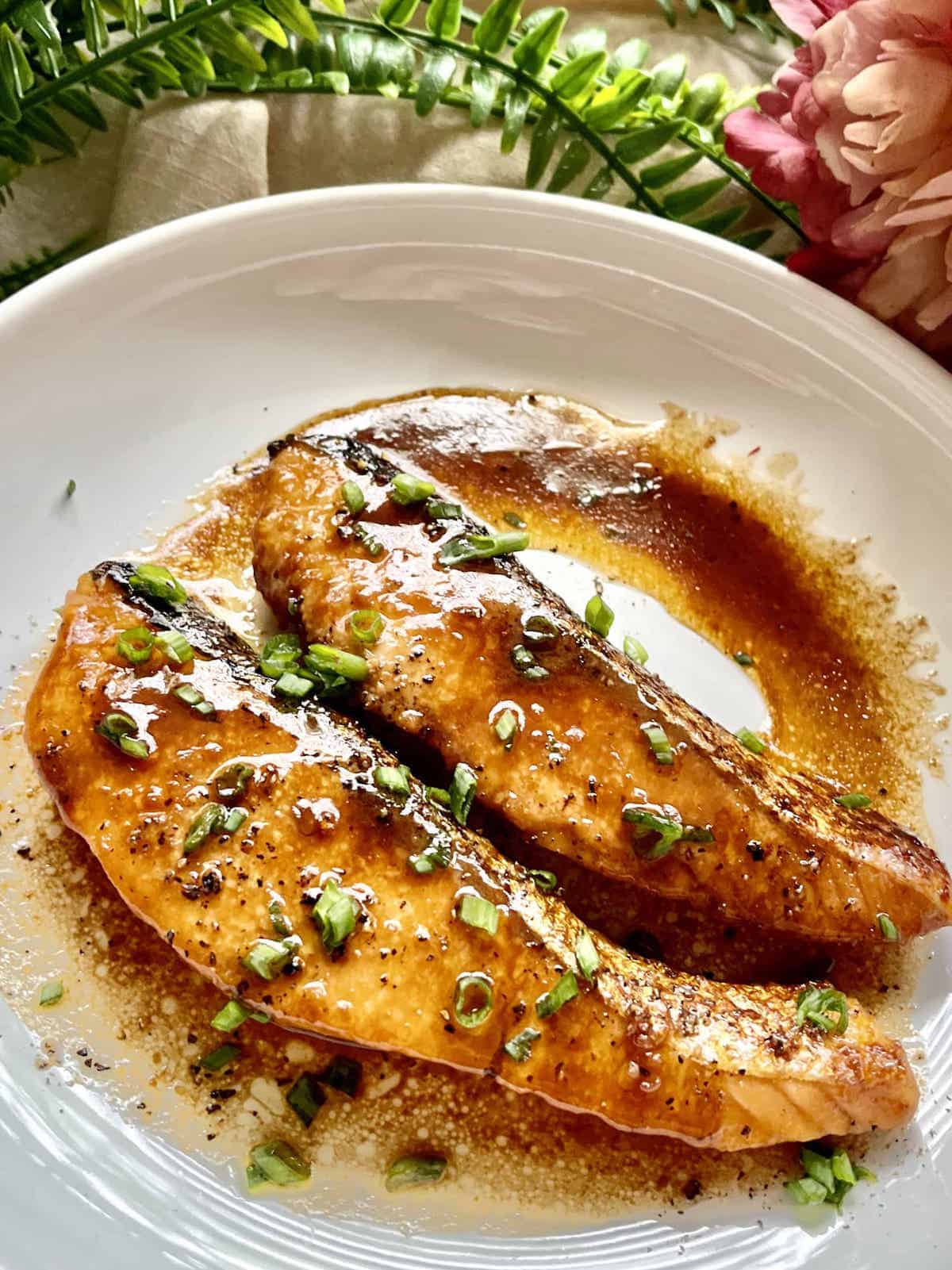
Jump to:
⭐ Why This Recipe is a Star
- Japanese Teriyaki Salmon 鮭の照り焼き is scrumptious: the thick, sweet, salty and savory glaze is umamilicious, and ever so good served with a side of rice! Honestly 1 of my favorite salmon recipes!
- Quick, budget-friendly and easy: it only requires under 5 simple ingredients. When pan-frying the salmon filets, you finish cooking in less than 10 minutes and it takes under a minute to make your own teriyaki sauce! Better and cheaper than any Japanese restaurant + Leftovers can be made into Teriyaki Salmon Lettuce Wraps or sauteed with pasta and noodles!
- Good for you: This delicious salmon is also a relatively healthy dish as salmon contains essential fatty acids. Moreover, the protein in the fish and umami in the sauce help to satiate you and prevent overeating! To make it even healthier, serve with a side of brown rice or cauliflower rice.
Note: I recommend pan-frying the fish when you're super hungry (It's quicker than baking as you don't need to wait for the oven to pre-heat.) Go for baking when you want a hands-off recipe (to give you time to make other sides such as green beans, a cucumber salad, sauteed bok choy, 1 of these Asian appetizers or 1 of these Japanese side dishes.)
What is Teriyaki?
Teriyaki actually refers to a style of Japanese cooking which dates back to the 1600s (and not the sauce, per se.)
It involves broiling or grilling foods in a soy, mirin and sugar glaze. This results in a thick, sweet and savory sauce. Teri (照り) refers to the gloss from the sugar in the sauce and yaki (焼き) refers to grilling or broiling.
The sauce goes well with a variety of foods, such as baked chicken thighs, tofu, sauteed shimeji mushrooms, and meatballs!
Note: With traditional teriyaki sauce, the food is brushed a few times during cooking, but I substitute that with basting in my recipe!
🥘 Ingredients
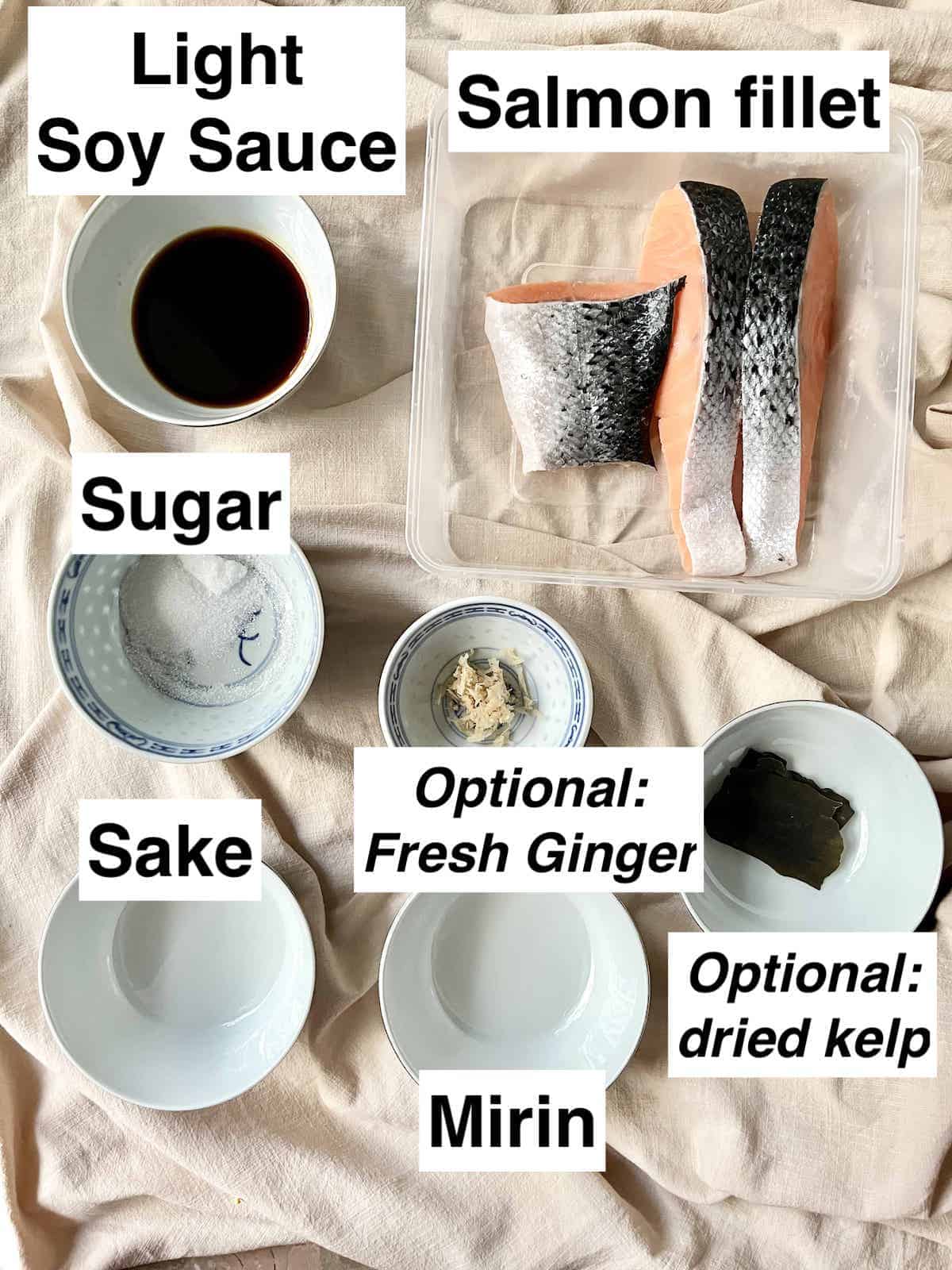
You only need a few simple ingredients, such as:
- Fresh Salmon Fillets: I recommend leaving the skin on as it keeps the flesh from drying out (so you get juicy salmon.) This is especially important when using wild salmon, which is drier- the skin helps to lock in the juices. (You can always remove it after cooking if it really annoys you!) If using frozen, thaw overnight in the fridge.
- Teriyaki sauce: you can get store-bought teriyaki sauce from any grocery store these days. However, I prefer homemade teriyaki sauce which is simply a mix of Sake, Mirin, Light Soy Sauce and White Sugar. (See below for recipe.)
- Ginger, optional but recommended: I do make this salmon recipe without ginger- when lazy to cut or grate!- but I find that adding the fresh ginger brings a bit of zing to cut through the richness of the salmon and sauce. If you don't have any ginger, sprinkling some sliced green onions over the cooked fillets will also bring some freshness to lift the flavor.
Note: If you have some, I also like to add 1-2 pieces of dried kelp to the marinade to give the teriyaki sauce just that little bit more umami! Adding a piece of kelp when you cook white rice also makes it taste better!
Homemade Teriyaki Sauce
You only need to mix the following 4 ingredients for a really savory teriyaki sauce.
Note: Some people heat or microwave the ingredients (to dissolve the sugar) before using it as a marinade, but I just stir a few times and I've never found it to affect my fish!
- Sake: Use drinking sake if possible as it does not have added sugars. I sometimes substitute with Korean soju, Chinese shaoxing or dry sherry depending on what's in my pantry.
- Mirin: If you don't have mirin, substitute with more sake or 1 of its substitutes and increase the sugar used. If you only have Chinese rice wine, click through for how to substitute Shaoxing for Mirin.
- Light soy sauce: do not substitute with Dark Soy Sauce, Thick Soy Sauce or Sweet Soy Sauce! (Although there are slight differences in flavor, you can use Korean or Chinese light soy if you can't get Japanese (I usually use Kikkoman or Lee Kum Kee.)) If you find it too salty, use reduced-sodium soy sauce/ low-sodium soy sauce or add a splash of water to the sauce ingredients.
- White Sugar can be replaced with honey, brown sugar, or maple syrup. However, if you're using honey for its health benefits, you may want to skip it. (Heating honey destroys its nutrients.)
Note: the sauce can be used for other ingredients such as tofu teriyaki, chicken or pork!
Variations
- You can brush the fish with 1 Tablespoon of corn starch or potato starch before pan-frying. This gives the filet a little crisp and helps the teriyaki adhere to the salmon better.
- You can also add sliced garlic or chilies to the marinade
- Some people drizzle sesame oil on the teriyaki glaze after cooking but I find it unnecessary, really.
- Add a tablespoon of butter when reducing the teriyaki glaze at the end, for a richer and more savory sauce, like with these soy sauce mushrooms!
- Some recipes add salt and black pepper to the fish before marinating but I don't find it necessary as the teriyaki glaze is super fragrant.
Note: in America, pineapple juice is sometimes used in teriyaki. It is a great tenderiser in, say, teriyaki chicken. Be careful with salmon though as the fish may become mushy if you marinade for too long.(Fish is more delicate than meat.)
🔪 Step-by-Step Instructions
The basic steps for pan-fried teriyaki salmon are:
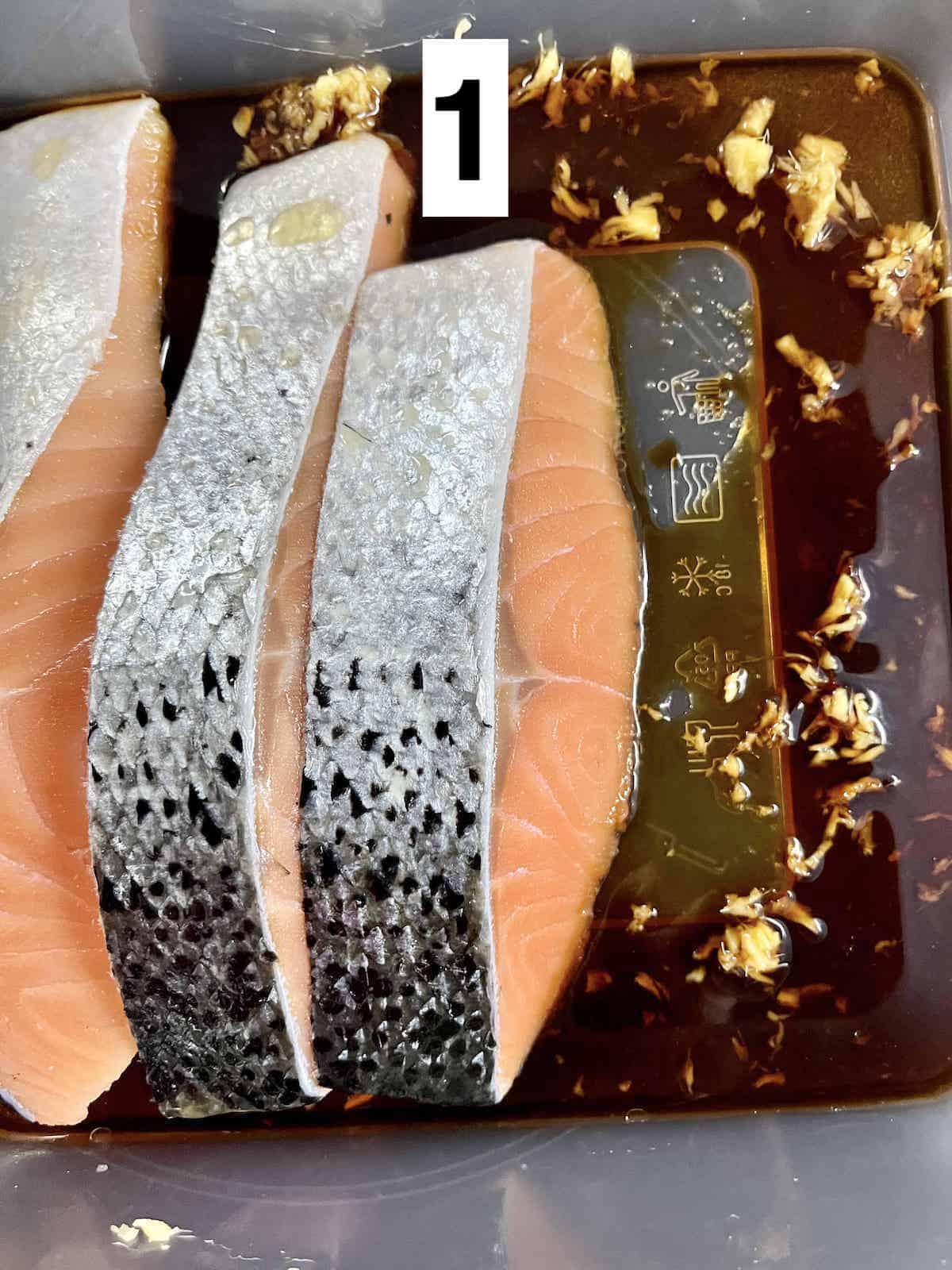
1a. Whisk together all the ingredients for the teriyaki sauce in a small bowl till well-mixed. Add the kelp if using.
1b. Pat dry the skin of the salmon (to ensure it is crisp later) and place skin-up in the sauce.
1c. Turn the salmon all round so that all sides are well-coated.
1d. Let the salmon come to room temperature, in the marinade, with the skin facing up.
Note: we want the raw salmon to come to room temperature before cooking (10-20 minutes) but don't leave it out for too long (food safety.) Definitely do not leave out for more than 2 hours (or less in some warmer climates!)
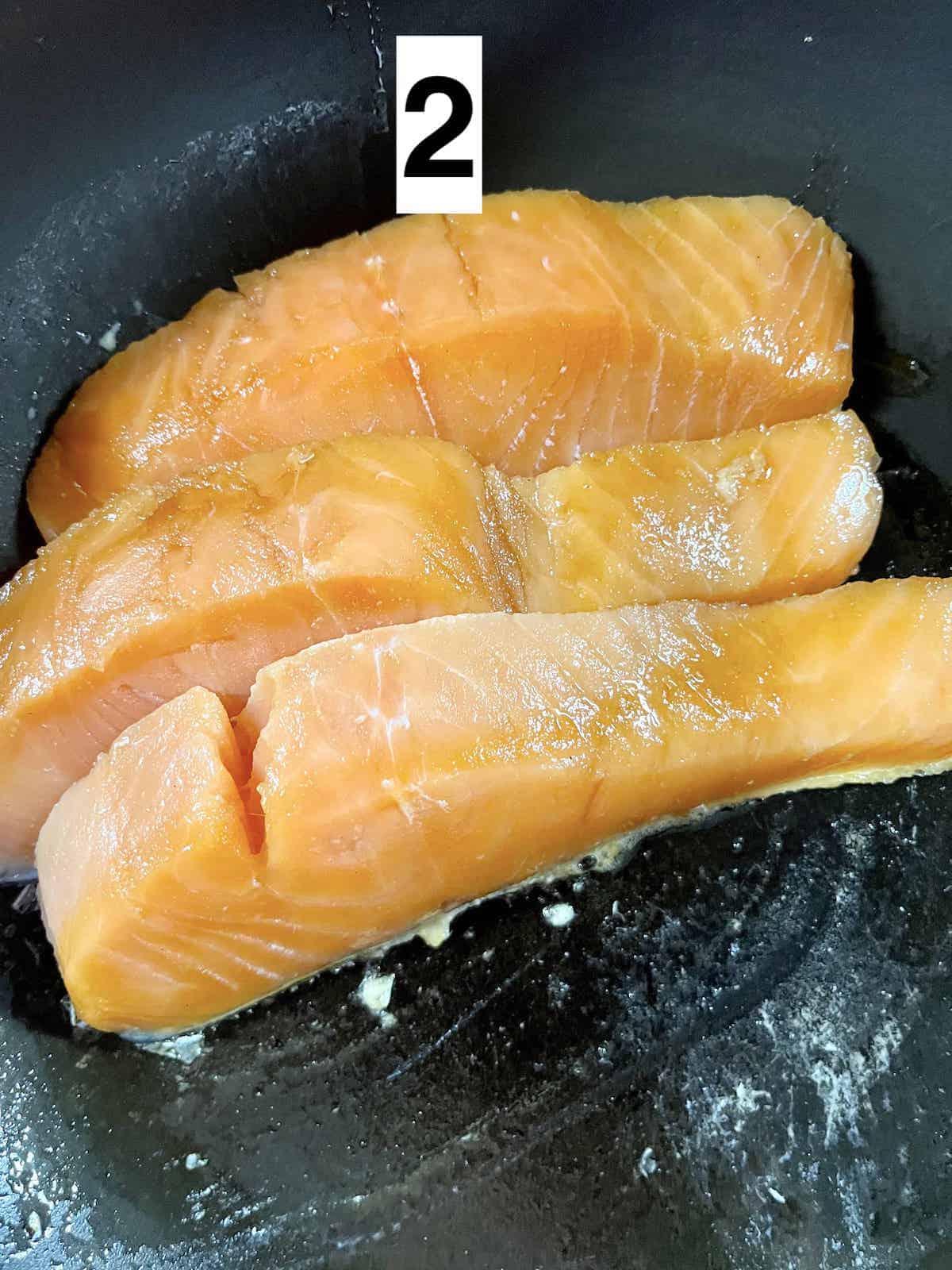
2a. Heat up the pan on medium-high heat then rub the surface of the pan with a knob of butter butter or drizzle with oil.
Note: the butter is not traditional but I like the flavor it brings.
2b. Once the oil is hot, use your spatula to press the salmon skin down for 10 seconds onto the hot pan so that it doesn't buckle up.
Note: be careful as some oil will splatter.
2c. Let the salmon cook for 3 minutes. Do not move it!
2d. Gently flip the salmon. Lower the heat to medium and cook for 5-7 minutes or till the salmon is cooked. (It should flake easily.) Baste the sides from time to time.
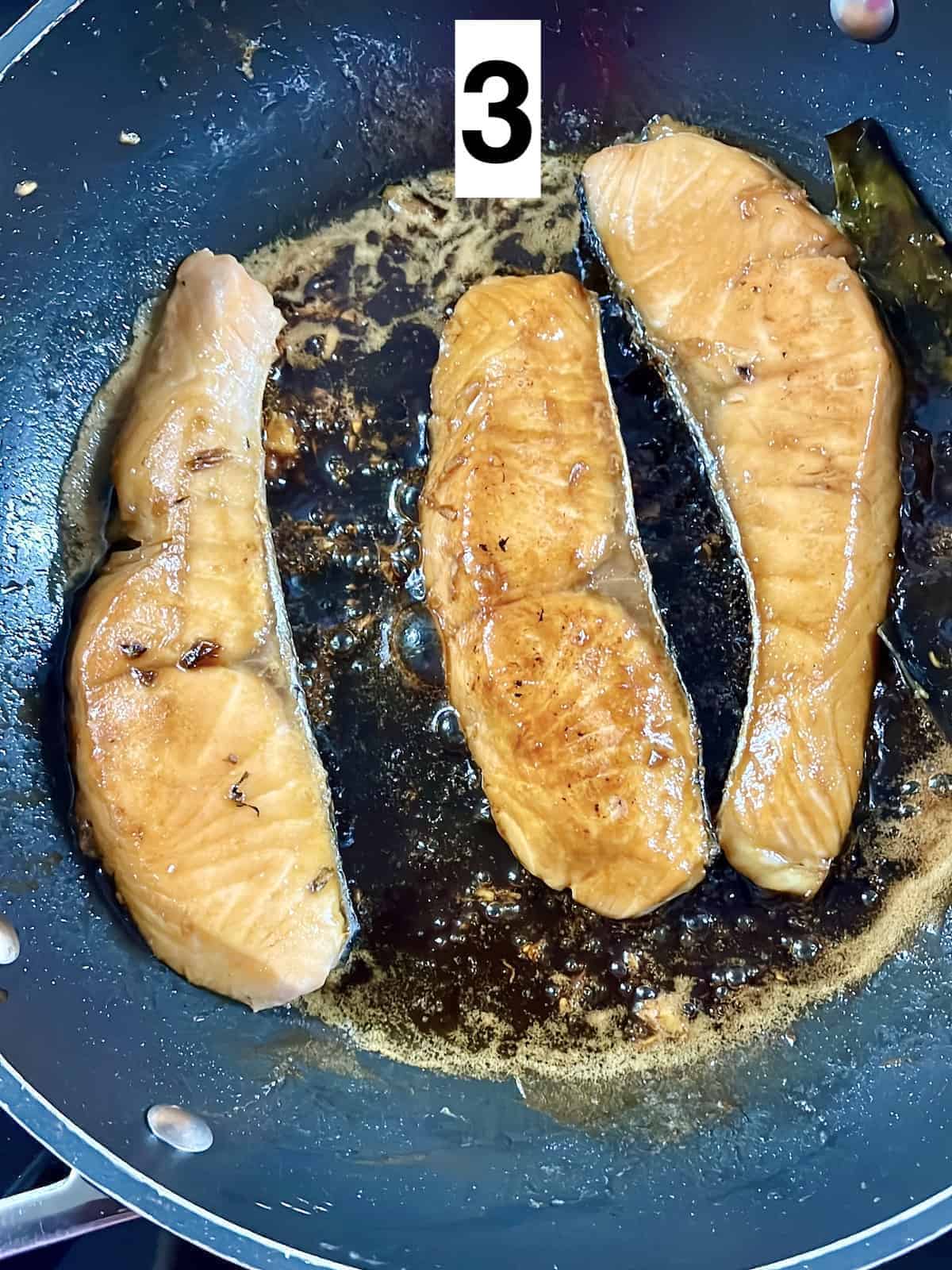
3a. Once the fish is cooked, plate it.
3b. If your sauce has not thickened sufficiently, turn up the fire and let it cook down to a nice glaze before switching off the fire. You can also add ½-1 Tablespoon of butter to make the sauce richer if you like.
3c. Return the fish to the pan and turn it in the sauce till coated.
Serve skin side up and enjoy!
Note: There is no need for a thickening agent like a cornstarch slurry!
For Baked Teriyaki Salmon
- Place a rack in the middle of the oven; preheat to 400F/ 200C/ Gas Mark 6.
- Line a baking tray (you can use aluminium foil or parchment paper, sprayed with oil or nonstick cooking spray. If broiling later, use foil as parchment paper can catch fire!)
- Before baking, brush the marinaded salmon with more of the marinade then bake, skin side down, for 10-15 minutes (or till cooked) depending on the thickness and type of salmon.
- You may want to baste the fish with the marinade halfway through baking!
- If your salmon doesn't have that nice dark glaze, you can finish up by broiling for a few minutes at the end.
- Whilst the fish is in the oven, boil down the marinade in a small saucepan to cook off any bacteria.
- Remove the cooked salmon from the oven and brush with more (cooked) sauce. Let the fish rest for a few minutes before cutting!
- Do not baste with uncooked marinade at this point as it has been in contact with the raw fish and contains bacteria!
Note: baking also works well if you want to serve a larger whole fillet for a bigger dinner party. The cooking time would increase though!
Internal Temperature
- For medium rare salmon, 120F (wild salmon)/125F (farmed salmon)
- For medium salmon, the internal temperature should be 130-140F
- For well done salmon, 145F.
How to Serve
Boil down the rest of the sweet teriyaki marinade to kill the bacteria, then use the extra to brush over your cooked fish. (Or you can use it as a sauce for Spam fries!)
You can also garnish the fish with sliced scallions and/ or lightly toasted sesame seeds.
Note: If I am baking the fish, I use the baking time to make a quick cucumber salad which is very refreshing with this dish.
🥡 How to Store
This spicy salmon dish tastes best freshly cooked!
If you have extras, store in an airtight container in the fridge for 2-3 days. I recommend reheating by steaming to keep the flesh tender. However, do note that the skin will no longer be crispy!
Alternatively, you can microwave for 1-2 minutes.
Tip: You may want to remove the skin and pan fry that to crisp it up, whilst steaming the fish meat.
I sometimes add leftover salmon teriyaki to my salmon sushi bake.
👩🏻🍳 Expert Tips
Tip #1: Don't overcrowd the pan. I find 2-3 filets per Le Creuset pan work the best.
Tip #2: I prefer using wild-caught salmon (often Coho salmon or Sockeye) as it's healthier. (Farmed salmon gets its color from dye and there have been concerns about sea lice and overuse of antibiotics!) However, it is much more costly. In addition, the flesh also has less fat inside, so can be easy to overcook. (It cooks more quickly.)
Tip #3: I suggest serving about 3-4 ounces (85-113g) of salmon per person, accompanied by side dishes such as potatoes, rice or 1 of these Japanese side dishes.
💭 Recipe FAQs
Thawed raw salmon in the fridge should be eaten within 1-2 days. Thawed cooked salmon can be kept in the fridge for 2-4 days.
Yes cooked salmon can be frozen. However, it should be eaten within 3 months of freezing or the quality of the flesh will deteriorate.
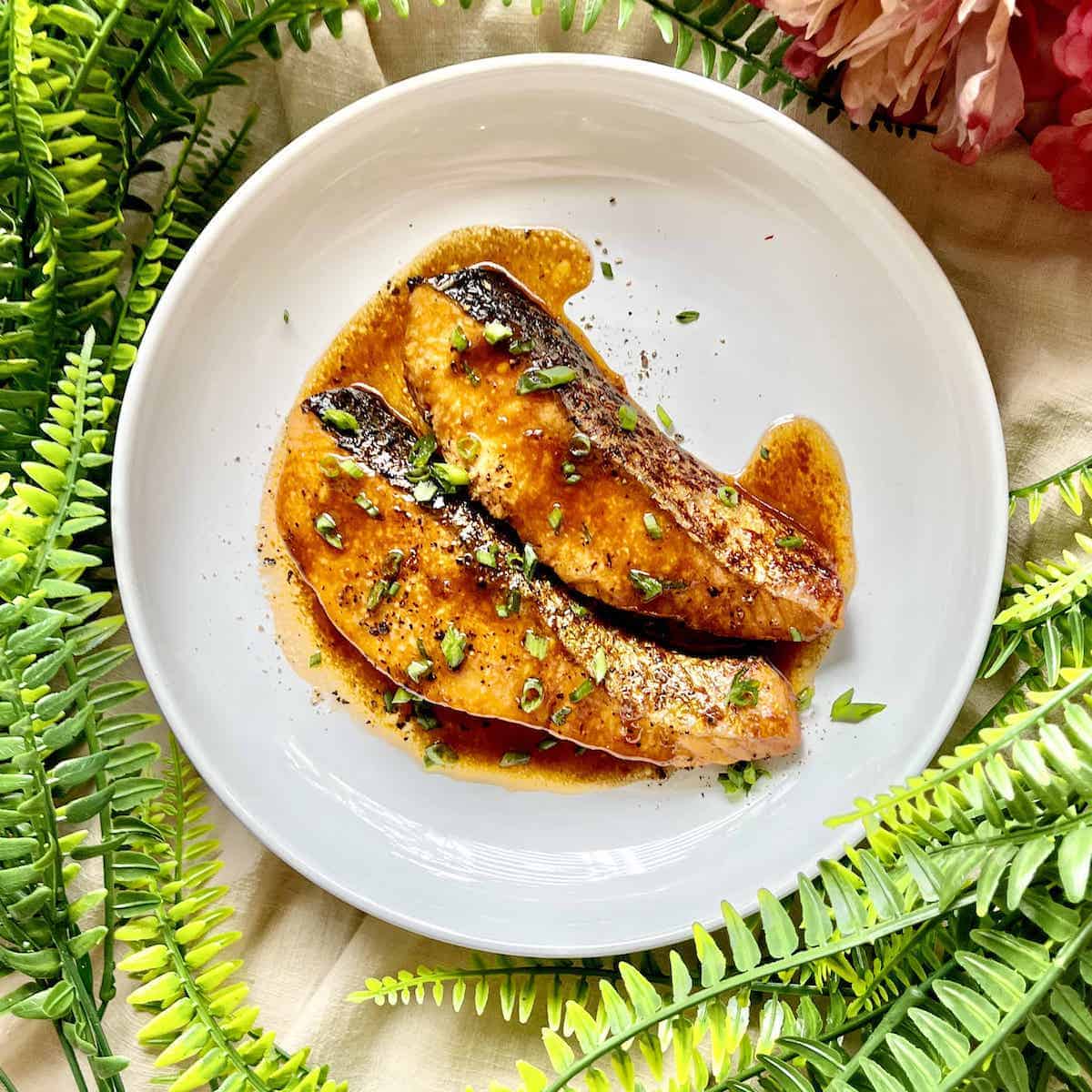
🥗 Suggested Side Dishes
Enjoyed this easy and healthy pan-fried Salmon Teriyaki Recipe? Please leave a 5-star 🌟🌟🌟🌟🌟rating in the recipe card below! If you REALLY liked this easy Japanese fish recipe, please consider supporting it by buying me a coffee! 🙂 (No obligation though!) Thank you and have a great day!
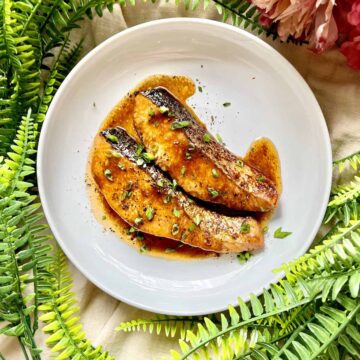
Pan-Fried Teriyaki Salmon (& Baked)
Equipment
- Pan Substitute if baking: oven
- Wooden or heatproof spatula Substitute if baking : baking sheet and aluminium foil/ baking paper
Ingredients
- 4 salmon fillets Let it come to room temperature before cooking. Wild salmon is preferable if you can afford it.
- Oil You can substitute with butter if pan frying.
Teriyaki Sauce
- 2 Tablespoons Light Soy Sauce
- 1 Tablespoon Mirin You can substitute with sake and sugar.
- 1 Tablespoon Sake Substitute: shaoxing, sherry or soju.
- 1 Tablespoon White Sugar Substitute: honey, maple syrup or brown sugar.
- 1 inch Fresh ginger grated or sliced, optionaal
- 4 dried kelp 1-inch per piece, optional
- Spring onions optional garnish
Instructions
Pan Fried
- Whisk together all the ingredients for the teriyaki sauce till well-mixed. Add the kelp if using.
- Pat dry the skin of the salmon (to ensure it is crisp later) and place skin-up in the sauce. Turn the salmon all round so that all sides are well-coated.
- Let the salmon come to room temperature, in the marinade, with the skin facing up.Note: we want the raw salmon to come to room temperature before cooking (10-20 minutes) but don't leave it out for too long (food safety.) Definitely do not leave out for more than 2 hours (or less in some warmer climates!)
- Heat up the pan on medium-high heat then rub the surface of the pan with a knob of butter butter or drizzle with oil. Note: the butter is not traditional but I like the flavor it brings.
- Once the oil is hot, press the salmon skin down for 10 seconds so that it doesn't buckle up. Let the salmon cook for 3 minutes. Do not move it!Note: be careful as some oil will splatter.
- Gently flip the salmon. Lower the heat to medium and cook for 5-7 minutes or till the salmon is cooked. (It should flake easily and be opaque when done.) Baste the sides from time to time.
- Once the fish is cooked, plate it. If your sauce has not thickened sufficiently, turn up the fire and let it cook down to a nice glaze before switching off the fire. You can also add ½-1 Tablespoon of butter to make the sauce richer if you like.
- Return the fish to the pan and turn it in the sauce till coated. Serve skin side up and enjoy!
Baked
- Place a rack in the middle of the oven; preheat to 400F/ 200C/ Gas Mark 6.
- Line a baking tray (you can use aluminium foil or parchment paper, sprayed with oil or nonstick cooking spray.)Note: If broiling later, use foil as parchment paper can catch fire!
- Before baking, let the salmon come to room temperature. Brush the marinaded salmon with more of the marinade then bake, skin side down, for 10-15 minutes (or till cooked) depending on the thickness and type of salmon. Note: You may want to baste the fish with the marinade halfway through baking!
- Whilst the fish is in the oven, boil down the marinade in a small saucepan to cook off any bacteria.
- Remove the cooked salmon from the oven and brush with more (cooked) sauce. Let the fish rest for a few minutes before cutting!Note: Do not baste with uncooked marinade at this point as it has been in contact with the raw fish and contains bacteria! If your salmon doesn't have that nice dark glaze, you can finish up by broiling for a few minutes at the end.
Notes
- For medium rare salmon, 120F (wild salmon)/125F (farmed salmon)
- For medium salmon, the internal temperature should be 130-140F
- For well done salmon, 145F.
Note: the nutritional information is an estimate automatically calculated using the WPRM recipe maker and I am not responsible for its veracity.
Nutrition
If this easy Teriyaki Salmon Recipe was helpful, maybe you'd like to try this Gochujang Salmon or to sign up for my newsletter in which I send you more tips and tricks to make authentic Asian food?

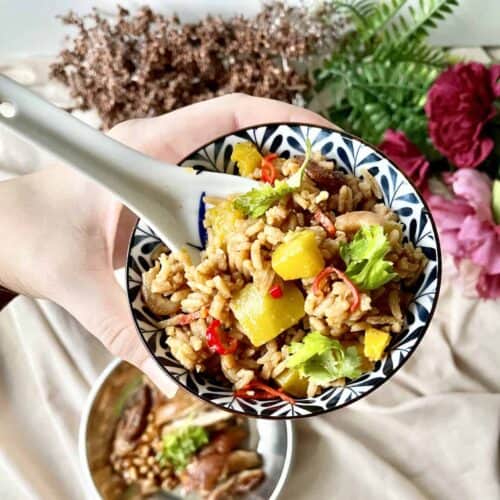
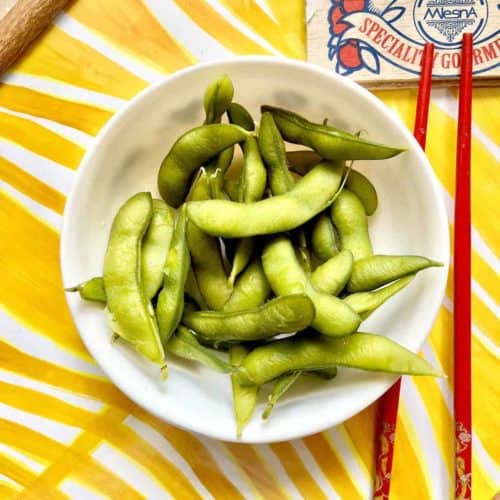

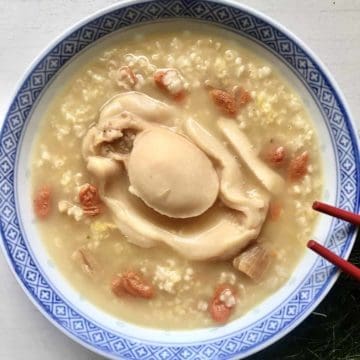
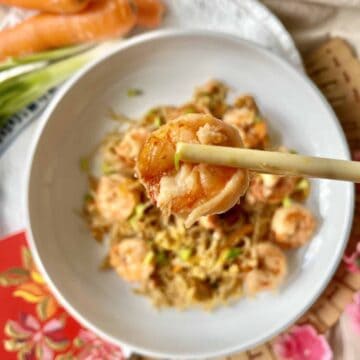
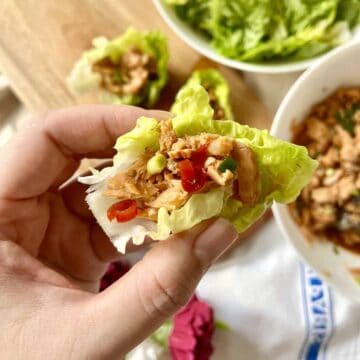
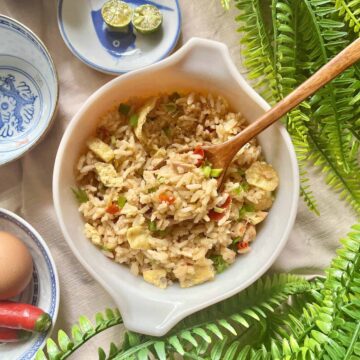
Dorene chew says
Teriyaki salmon - I prefer it pan fried : yumi!!